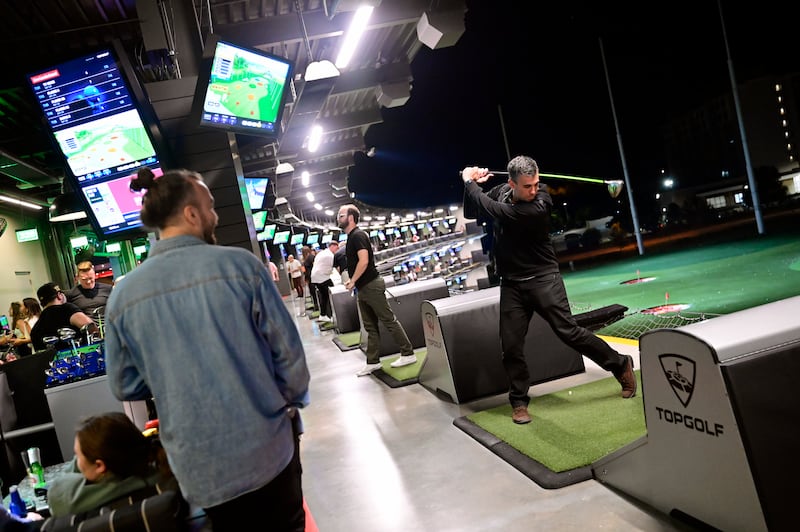Over the past few years, mysterious, gargantuan structures began suddenly springing up all across the United States. Stake poles and vast nets stretched for a quarter of a mile and nosed 150ft into the sky. Usually located near highways, these sprawling concerns with stadium-standard floodlights resembled some alien craft stamping an oversized footprint on suburbia. Except the point of this invasion was not to colonise the natives but to evangelise; these behemoths were missionaries bent on persuading non-golfers to take clubs in their hands for the first time.
“It’s golf. It’s not golf. It’s Topgolf!” blared the company slogan.
At last count, there were more than 80 Topgolf facilities in America, enormous triple-decked driving ranges, sporting blots on the landscape that offer a raucous atmosphere more akin to a nightclub than a country club. Television screens abound, music is blaring, beers are flowing and wings are being chomped, all amid the relentless thwack of microchipped balls arcing hither and yon. More Justified Ancients of Mu Mu than Royal and Ancient.
In this curious hybrid incorporating video games such as Angry Birds and Sonic the Hedgehog, there are all manner of gimmicky ways to play, and the swings are very often agricultural. No matter. Not many are there to fine-tune their takeaways. These young men and women, most of them couldn’t tell the difference between Scottie Scheffler and Xander Schauffele, and think Wyndham Clark is a brand of hotel. Drivers in their hands, they don’t really have quality fades and draws on their minds.
Unlike playing 18 holes on a real course, Topgolf doesn’t take five hours or require observing rules of etiquette stitched together by stuffed shirts back in the day. Perhaps most importantly of all, you don’t have to be any good at this version to knock serious fun out of it. Complete novices, more than half their customer base, can still enjoy the experience and this may be why young people, that most coveted demographic, have thronged these venues in the past couple of years. Some have come to hit balls. Others to date. More just to hang. In a country where they can’t get into pubs, gaggles of high schoolers can be found there.

That mesmeric decade of Tiger Woods’s dominance apart, golf has always been the naffest of sports, its sheer middle-agedness struggling to attract those for whom it is not a family heirloom. More than 800 American courses have closed since 2010, and for years Jack Nicklaus, among others, beat the drum about needing a pacier, more accessible model to bring in the youth.
Well, here it is. In what is now labelled the off-course golf entertainment industry, Topgolf, Five Iron Golf (a smaller-scale indoor driving range that uses computerised simulators), and their competitors have created a more exciting, immediate alternative to the real thing. They’ve made the whole experience so weirdly cool Callaway spent $2.6 billion (€2.46 billion) purchasing Topgolf three years back.
Unfortunately, the one thing this version has in common with regular golf is that it’s ludicrously expensive. Depending on the time of day or night, and the number of participants, an all-weather bay can cost between $30 and $90 per hour at Topgolf. Clubs are provided free, but food and drinks are priced high, near enough to what you might pay at any major sports stadium. And yet, nearly six million Americans between 18 and 35 teed it up at one of these venues last year. It’s estimated that 25 per cent of first-time players were intrigued enough by the experience to go on to give a real course a try.
In the eternal battle to lure newcomers and especially women to the sport, the virtual space is a busy and successful front. Woods and Rory McIlroy are seeking to tap into this zeitgeist with the launch of TGL, their high-tech indoor golf league that will be televised live by ESPN in January. Using state-of-the-art simulators, they will play 15 holes per match while wearing microphones and adhering to a shot clock. Somewhere in Augusta National, the azaleas must be wilting at the heresy of it all.
The innovations don’t stop there. The Major League Baseball season just ended, and the Atlanta Braves don’t play a home game again until next April. But, for the next three days, their beloved Truist Park will be transformed to host something called Upper Deck golf. Tee-boxes will be set up at nine different perches around the cavernous arena, from where players try to hit target greens etched out on the field down below. As with Topgolf, the action is soundtracked by loud music and fuelled by expensive food and drink, none of which is covered by the $90 green fees.
Upper Deck has been at this lark for five years, taking its roadshow to every NFL and MLB stadium that wanted to keep the tills ringing on the down days. Even Fenway Park, John Updike’s “lyric little bandbox” in Boston, has played host to the novelty act. If very few people ever get to face a pitch and take a swing at home plate on that historic turf, this newfangled idea provides an opportunity for fans to climb the bleachers and drive a smaller ball in the direction of the Green Monster. You don’t have to be into the game to appreciate there’s a certain thrill in that. Whether it’s considered golf or not golf.

















